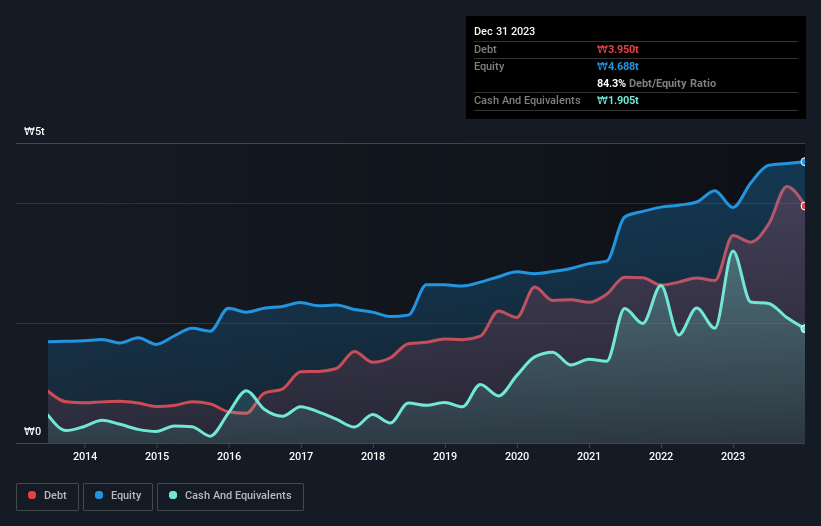- South Korea
- /
- Aerospace & Defense
- /
- KOSE:A012450
Hanwha Aerospace (KRX:012450) Seems To Use Debt Quite Sensibly

Legendary fund manager Li Lu (who Charlie Munger backed) once said, 'The biggest investment risk is not the volatility of prices, but whether you will suffer a permanent loss of capital.' It's only natural to consider a company's balance sheet when you examine how risky it is, since debt is often involved when a business collapses. As with many other companies Hanwha Aerospace Co., Ltd. (KRX:012450) makes use of debt. But the more important question is: how much risk is that debt creating?
When Is Debt Dangerous?
Debt is a tool to help businesses grow, but if a business is incapable of paying off its lenders, then it exists at their mercy. Part and parcel of capitalism is the process of 'creative destruction' where failed businesses are mercilessly liquidated by their bankers. However, a more frequent (but still costly) occurrence is where a company must issue shares at bargain-basement prices, permanently diluting shareholders, just to shore up its balance sheet. By replacing dilution, though, debt can be an extremely good tool for businesses that need capital to invest in growth at high rates of return. When we think about a company's use of debt, we first look at cash and debt together.
View our latest analysis for Hanwha Aerospace
What Is Hanwha Aerospace's Debt?
As you can see below, at the end of December 2023, Hanwha Aerospace had ₩3.95t of debt, up from ₩3.46t a year ago. Click the image for more detail. However, because it has a cash reserve of ₩1.91t, its net debt is less, at about ₩2.05t.

A Look At Hanwha Aerospace's Liabilities
According to the last reported balance sheet, Hanwha Aerospace had liabilities of ₩12t due within 12 months, and liabilities of ₩2.78t due beyond 12 months. Offsetting this, it had ₩1.91t in cash and ₩2.12t in receivables that were due within 12 months. So its liabilities outweigh the sum of its cash and (near-term) receivables by ₩11t.
This deficit is considerable relative to its market capitalization of ₩11t, so it does suggest shareholders should keep an eye on Hanwha Aerospace's use of debt. This suggests shareholders would be heavily diluted if the company needed to shore up its balance sheet in a hurry.
We use two main ratios to inform us about debt levels relative to earnings. The first is net debt divided by earnings before interest, tax, depreciation, and amortization (EBITDA), while the second is how many times its earnings before interest and tax (EBIT) covers its interest expense (or its interest cover, for short). The advantage of this approach is that we take into account both the absolute quantum of debt (with net debt to EBITDA) and the actual interest expenses associated with that debt (with its interest cover ratio).
Hanwha Aerospace's net debt of 2.0 times EBITDA suggests graceful use of debt. And the alluring interest cover (EBIT of 8.1 times interest expense) certainly does not do anything to dispel this impression. It is well worth noting that Hanwha Aerospace's EBIT shot up like bamboo after rain, gaining 72% in the last twelve months. That'll make it easier to manage its debt. There's no doubt that we learn most about debt from the balance sheet. But ultimately the future profitability of the business will decide if Hanwha Aerospace can strengthen its balance sheet over time. So if you're focused on the future you can check out this free report showing analyst profit forecasts.
Finally, while the tax-man may adore accounting profits, lenders only accept cold hard cash. So we clearly need to look at whether that EBIT is leading to corresponding free cash flow. Over the last three years, Hanwha Aerospace actually produced more free cash flow than EBIT. That sort of strong cash generation warms our hearts like a puppy in a bumblebee suit.
Our View
Happily, Hanwha Aerospace's impressive conversion of EBIT to free cash flow implies it has the upper hand on its debt. But the stark truth is that we are concerned by its level of total liabilities. All these things considered, it appears that Hanwha Aerospace can comfortably handle its current debt levels. Of course, while this leverage can enhance returns on equity, it does bring more risk, so it's worth keeping an eye on this one. The balance sheet is clearly the area to focus on when you are analysing debt. However, not all investment risk resides within the balance sheet - far from it. For example, we've discovered 2 warning signs for Hanwha Aerospace that you should be aware of before investing here.
At the end of the day, it's often better to focus on companies that are free from net debt. You can access our special list of such companies (all with a track record of profit growth). It's free.
Valuation is complex, but we're here to simplify it.
Discover if Hanwha Aerospace might be undervalued or overvalued with our detailed analysis, featuring fair value estimates, potential risks, dividends, insider trades, and its financial condition.
Access Free AnalysisHave feedback on this article? Concerned about the content? Get in touch with us directly. Alternatively, email editorial-team (at) simplywallst.com.
This article by Simply Wall St is general in nature. We provide commentary based on historical data and analyst forecasts only using an unbiased methodology and our articles are not intended to be financial advice. It does not constitute a recommendation to buy or sell any stock, and does not take account of your objectives, or your financial situation. We aim to bring you long-term focused analysis driven by fundamental data. Note that our analysis may not factor in the latest price-sensitive company announcements or qualitative material. Simply Wall St has no position in any stocks mentioned.
About KOSE:A012450
Hanwha Aerospace
Engages in the development, production, and maintenance of aircraft engines worldwide.
Outstanding track record and good value.
Market Insights
Community Narratives



